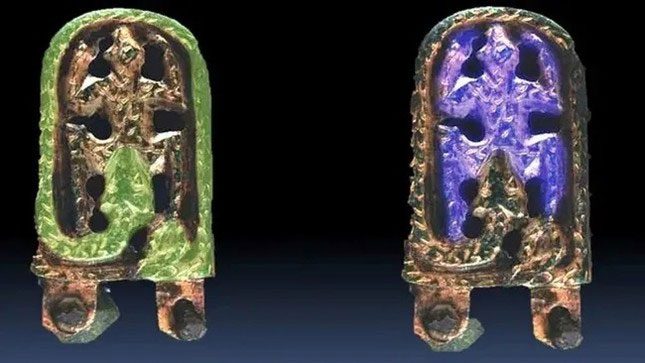The bronze belt buckle, dating back to the 8th century, features a central design depicting a snake or dragon devouring a frog-like creature, which researchers today believe symbolizes a pagan cult.
The belt or bronze buckle was discovered by a metal detector near the village of Lány, about 32 kilometers west of Prague.

Archaeologists indicate that the depiction of a dragon or snake consuming a frog on this medieval belt in the Czech Republic could represent the symbol of an unnamed pagan cult.
Initially, archaeologists thought that the central design—a snake or dragon devouring a frog-like creature—was unique, but they have since realized that over the past several decades, similar artifacts have been unearthed in Germany, Hungary, and elsewhere in the Czech Republic.
Jiří Macháček, an archaeologist at Masaryk University in Brno, stated: “I recognize that we are looking at an unprecedented pagan cult that connected various regions in Central Europe in the early Middle Ages, before the advent of Christianity.”
He continued: “The motif of a snake or dragon devouring its victim appears in German, Avar, and Slavic mythology. Today, we can only speculate about its exact meaning, but in the early Middle Ages, it connected the diverse peoples living there.”
Macháček is the lead author of a study published in the January 2024 issue of the Journal of Archaeological Science that describes the Lány belt and three others: one found near Iffeldorf in southern Germany, approximately 325 kilometers southwest of Lány; another near Zsámbék, Hungary, about 450 kilometers southeast of Lány; and a third found near the town of Nový Bydžov in the Czech Republic, situated about 110 kilometers east of Lány.
Pagan Symbolism?
Previous research indicates that such belt accessories were produced in Central Europe during the 7th and 8th centuries and were commonly worn by the Avars—a nomadic people believed to have originated from the Eurasian steppes, who settled in the Carpathian basin, present-day Hungary, starting in the 6th century.
Researchers note that the Avars established a “khaganate” or nomadic state over much of Central Europe, and some of their fashion styles were adopted by other peoples in the region, many of whom were Slavs.
X-ray fluorescence analysis, scanning electron microscopy, and other techniques show that these artifacts were originally heavily gilded, and all four items were made from copper mined in the Slovak Ore Mountains, now part of Slovakia.
An analysis of their shapes based on virtual 3D models suggests that some of the buckles or accessories originated from the same workshop or were made from a common mold, using the method of bronze casting.
Researchers assert that the remarkable similarity of these objects indicates the existence of an unprecedented pagan cult that connected diverse population groups of different origins during the early Middle Ages.
The true significance of the snake—or dragon—and the frog-like creature remains unknown, but researchers observe that the struggle with a snake or dragon is common in creation myths of paganism, as the opposition between two opposing forces symbolizes the central act of creation. They write in their study that “the myth of the cosmos,” “the interaction” between the snake and the frog may relate to fertility worship activities.


















































